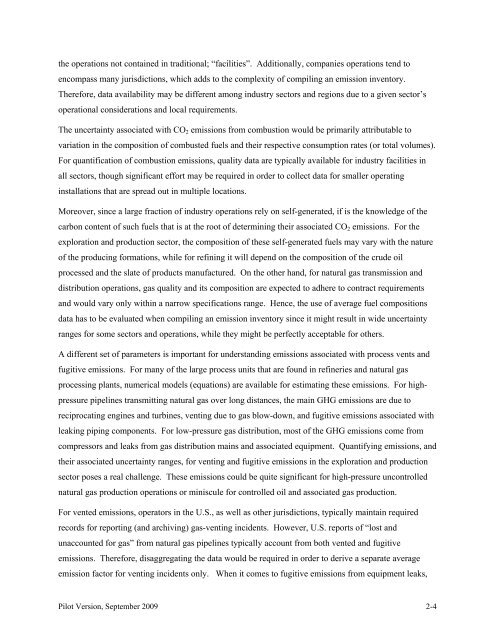addressing uncertainty in oil and natural gas industry greenhouse
addressing uncertainty in oil and natural gas industry greenhouse
addressing uncertainty in oil and natural gas industry greenhouse
Create successful ePaper yourself
Turn your PDF publications into a flip-book with our unique Google optimized e-Paper software.
the operations not conta<strong>in</strong>ed <strong>in</strong> traditional; “facilities”. Additionally, companies operations tend to<br />
encompass many jurisdictions, which adds to the complexity of compil<strong>in</strong>g an emission <strong>in</strong>ventory.<br />
Therefore, data availability may be different among <strong>in</strong>dustry sectors <strong>and</strong> regions due to a given sector’s<br />
operational considerations <strong>and</strong> local requirements.<br />
The <strong>uncerta<strong>in</strong>ty</strong> associated with CO 2 emissions from combustion would be primarily attributable to<br />
variation <strong>in</strong> the composition of combusted fuels <strong>and</strong> their respective consumption rates (or total volumes).<br />
For quantification of combustion emissions, quality data are typically available for <strong>in</strong>dustry facilities <strong>in</strong><br />
all sectors, though significant effort may be required <strong>in</strong> order to collect data for smaller operat<strong>in</strong>g<br />
<strong>in</strong>stallations that are spread out <strong>in</strong> multiple locations.<br />
Moreover, s<strong>in</strong>ce a large fraction of <strong>in</strong>dustry operations rely on self-generated, if is the knowledge of the<br />
carbon content of such fuels that is at the root of determ<strong>in</strong><strong>in</strong>g their associated CO 2 emissions. For the<br />
exploration <strong>and</strong> production sector, the composition of these self-generated fuels may vary with the nature<br />
of the produc<strong>in</strong>g formations, while for ref<strong>in</strong><strong>in</strong>g it will depend on the composition of the crude <strong>oil</strong><br />
processed <strong>and</strong> the slate of products manufactured. On the other h<strong>and</strong>, for <strong>natural</strong> <strong>gas</strong> transmission <strong>and</strong><br />
distribution operations, <strong>gas</strong> quality <strong>and</strong> its composition are expected to adhere to contract requirements<br />
<strong>and</strong> would vary only with<strong>in</strong> a narrow specifications range. Hence, the use of average fuel compositions<br />
data has to be evaluated when compil<strong>in</strong>g an emission <strong>in</strong>ventory s<strong>in</strong>ce it might result <strong>in</strong> wide <strong>uncerta<strong>in</strong>ty</strong><br />
ranges for some sectors <strong>and</strong> operations, while they might be perfectly acceptable for others.<br />
A different set of parameters is important for underst<strong>and</strong><strong>in</strong>g emissions associated with process vents <strong>and</strong><br />
fugitive emissions. For many of the large process units that are found <strong>in</strong> ref<strong>in</strong>eries <strong>and</strong> <strong>natural</strong> <strong>gas</strong><br />
process<strong>in</strong>g plants, numerical models (equations) are available for estimat<strong>in</strong>g these emissions. For highpressure<br />
pipel<strong>in</strong>es transmitt<strong>in</strong>g <strong>natural</strong> <strong>gas</strong> over long distances, the ma<strong>in</strong> GHG emissions are due to<br />
reciprocat<strong>in</strong>g eng<strong>in</strong>es <strong>and</strong> turb<strong>in</strong>es, vent<strong>in</strong>g due to <strong>gas</strong> blow-down, <strong>and</strong> fugitive emissions associated with<br />
leak<strong>in</strong>g pip<strong>in</strong>g components. For low-pressure <strong>gas</strong> distribution, most of the GHG emissions come from<br />
compressors <strong>and</strong> leaks from <strong>gas</strong> distribution ma<strong>in</strong>s <strong>and</strong> associated equipment. Quantify<strong>in</strong>g emissions, <strong>and</strong><br />
their associated <strong>uncerta<strong>in</strong>ty</strong> ranges, for vent<strong>in</strong>g <strong>and</strong> fugitive emissions <strong>in</strong> the exploration <strong>and</strong> production<br />
sector poses a real challenge. These emissions could be quite significant for high-pressure uncontrolled<br />
<strong>natural</strong> <strong>gas</strong> production operations or m<strong>in</strong>iscule for controlled <strong>oil</strong> <strong>and</strong> associated <strong>gas</strong> production.<br />
For vented emissions, operators <strong>in</strong> the U.S., as well as other jurisdictions, typically ma<strong>in</strong>ta<strong>in</strong> required<br />
records for report<strong>in</strong>g (<strong>and</strong> archiv<strong>in</strong>g) <strong>gas</strong>-vent<strong>in</strong>g <strong>in</strong>cidents. However, U.S. reports of “lost <strong>and</strong><br />
unaccounted for <strong>gas</strong>” from <strong>natural</strong> <strong>gas</strong> pipel<strong>in</strong>es typically account from both vented <strong>and</strong> fugitive<br />
emissions. Therefore, disaggregat<strong>in</strong>g the data would be required <strong>in</strong> order to derive a separate average<br />
emission factor for vent<strong>in</strong>g <strong>in</strong>cidents only. When it comes to fugitive emissions from equipment leaks,<br />
Pilot Version, September 2009 2-4

















